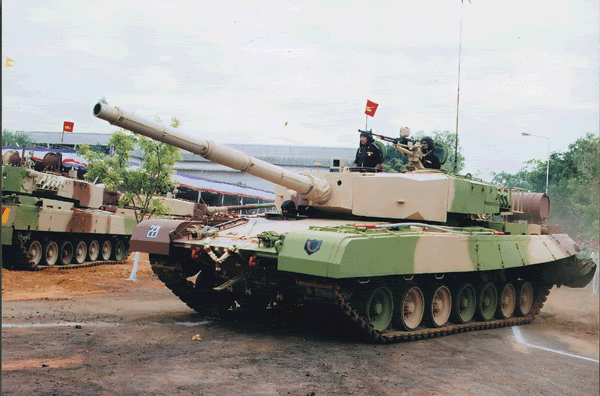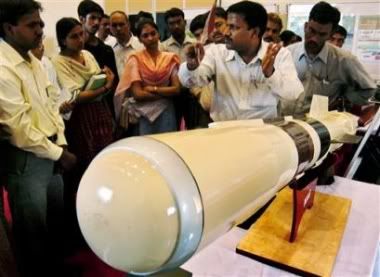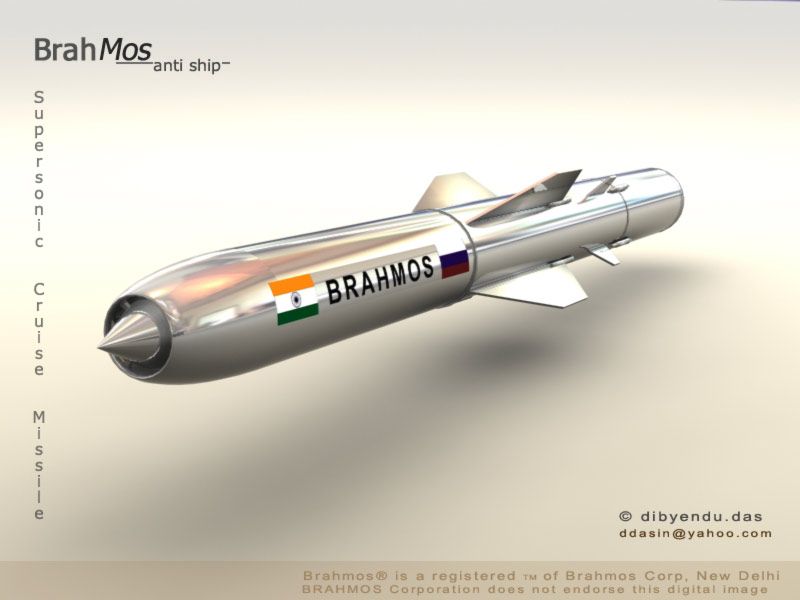Now, this article is about four years old so it probably doesn't apply to current standards, but it does raise an eyebrow to what happened after the Kargil period. Please, no flammers or country bashing. Please discuss in a civilized manner.
Toothless Tigers:
Milan, a surface-to-surface missile that could not be fired during the Kargil war, explodes in the factory where it is being manufactured. laugh.gif
Trishul, an all-weather surface-to-air missile, the non-delivery of which has hit the Indian Navy hard, blows up in an arms depot. laugh.gif
Something seems to be going wrong with the indigenous missiles being developed by the Defence Research and Development Organisation since the last two decades.
DRDO officials insist they are not facing any problems. But two explosions in less than four months -- one at Hyderabad and the other in Cochin -- are beginning to raise questions about India's missile programme. They have resulted in the destruction of an unknown number of Milan missiles and in yet another delay on the delivery of the crucial Trishul missile system which has, for years now, been the DRDO's flagship project.
There are no answers to what happened at Bharat Dynamics Limited, the DRDO's Hyderabad-based production centre for missile systems, on January 4. Milan, a second-generation anti-tank guided missile, exploded as it was accidentally released during an inspection by a high-level team led by Defence Secretary Yogesh Narain. It charred quality control inspector Narasimhachari and seriously injured five others. The DRDO announced a high-level inquiry into the incident, but its report has been kept secret.
Meanwhile, BDL, the hub of the country's ambitious Integrated Guided Missile Programme, is faced with another serious crisis: how to resurrect nearly 1,000 Milan and Konkur missiles that were damaged in the explosion.
When the Milan missile blew up and a fire erupted in BDL, the panicky firemen and in-house security personnel doused the entire range of missiles stored in BDL's explosives unit. The resultant eight inches of water that flooded the area, say official sources, has virtually ruined the missiles.
"The Milan accident and the water-logging of hundreds of other missiles has hit our delivery schedule of these weapons to the Indian Army," conceded a BDL official even as he said efforts were on to repair the water-damaged missiles.
BDL has, under a technology transfer agreement with Euromissile -- an international consortium of the French Aerospatiale Group and the German MBB Group -- been manufacturing the Milan since 1981. Similarly, the Konkurs have been developed under a licence agreement with Russia. BDL has even perfected a special kit and propeller that can launch Milans and Konkurs both from the ground and from army vehicles.
The defence ministry formed BDL in 1970. The DRDO's most prestigious agency, it is also responsible for the manufacture of the indigenous Prithvi. These missiles, which are produced at a cost of Rs 35 million each, are stored at the BDL factory. Which is why the Milan explosion has the DRDO worried.
Since 1999, both the DRDO and BDL have been carrying out numerous tests on the Milan to find out why they performed so dismally during the Kargil war. The army deployed nearly 200 Milans in Kargil, but could not use many of them. The DDRO, though, claims it is incorrect to say the Milans failed in Kargil. "They could not be fired because of the height in Kargil. The missile is technologically perfect," says a senior DRDO official.
BDL officials say the very fact that the army has placed an additional order of 250 Milans proves the superiority of these missiles. Yet, certain aspects continue to remain cause for worry.
Officials reveal the DRDO has a secret report, which cites "substandard material" as the reason for its accidental explosion in Hyderabad. Besides, the Central Bureau of Investigation has already probed allegations of kickbacks, which surfaced five years ago during the purchase of Milan spares. According to the CBI, BDL bought 4,000 units of spare parts for Milan from a Czechoslovakian company at the cost of US $500,000 without calling for tenders. It is these imported spares that may be "the substandard material" behind the Milan explosion.
Are substandard materials and spares also being used in the production of the Trishul? DRDO officials vehemently deny this. But they cannot explain why a Trishul missile exploded in the Naval Armament Depot in Cochin on April 10. The missile was bought from BDL to Cochin to be test-fired by the Southern Naval Command. It blew up when being tested by engineers and technicians, killing one BDL engineer and injuring three.
DRDO says a high-level technical team is probing the mishap. Its report, though, is unlikely to be made public. What is certain is that the Trishul, whose non-induction has hit the Indian Navy hard, continues to remain a mirage for the armed forces.
The Trishul's development actually began in 1983; it was scheduled to be ready by 1992. But the project, on which the DRDO has already spent Rs 2.6 billion, is still undergoing trials. The major problem is that the missile's command guidance does not work. Was this the reason for the explosion in Cochin?
"No," says a DRDO engineer. "That happened because of some serious electric problems in the missile. Because of the explosion, the Trishul will remain in our lab for further testing for some more months."
DRDO officials privately concede that the blast will considerably delay the ambitious project to indigenously develop and induct the missile into the navy. The DDRO has been trying to build and induct the Trishul -- along with the Prithvi, Akash, Agni and Nag -- into the armed forces for nearly two decades now. But its track record has been far from satisfactory. CLAPING.GIF
In fact, the navy has often registered its protest about the prolonged delay in the delivery of missiles like the Trishul. Last year, it had perforce to commission the state-of-the-art missile frigate, INS Brahmaputra, without the Trishul. In the continued absence of the Trishul, Israel's tried and tested Barak missile system is proving a favourite with the Navy.
The Trishul incorporates state-of-the-art beam guidance technology that can effectively counter an adversary aircraft or sea-skimming missile. As of now, an Indian naval ship without a missile like the Trishul is like a toothless tiger. The question is: how long will the navy continue to pin its hopes on a missile that the DRDO has been promising to induct for years?
Now, has the Trishul been inducted in the IN yet? Are there plans to induct it in the IN? I know for a fact that the Akash missile (probably a decent copy of the SA-6) has been ordered by the Army, but what about the Trishul?
Toothless Tigers:
Milan, a surface-to-surface missile that could not be fired during the Kargil war, explodes in the factory where it is being manufactured. laugh.gif
Trishul, an all-weather surface-to-air missile, the non-delivery of which has hit the Indian Navy hard, blows up in an arms depot. laugh.gif
Something seems to be going wrong with the indigenous missiles being developed by the Defence Research and Development Organisation since the last two decades.
DRDO officials insist they are not facing any problems. But two explosions in less than four months -- one at Hyderabad and the other in Cochin -- are beginning to raise questions about India's missile programme. They have resulted in the destruction of an unknown number of Milan missiles and in yet another delay on the delivery of the crucial Trishul missile system which has, for years now, been the DRDO's flagship project.
There are no answers to what happened at Bharat Dynamics Limited, the DRDO's Hyderabad-based production centre for missile systems, on January 4. Milan, a second-generation anti-tank guided missile, exploded as it was accidentally released during an inspection by a high-level team led by Defence Secretary Yogesh Narain. It charred quality control inspector Narasimhachari and seriously injured five others. The DRDO announced a high-level inquiry into the incident, but its report has been kept secret.
Meanwhile, BDL, the hub of the country's ambitious Integrated Guided Missile Programme, is faced with another serious crisis: how to resurrect nearly 1,000 Milan and Konkur missiles that were damaged in the explosion.
When the Milan missile blew up and a fire erupted in BDL, the panicky firemen and in-house security personnel doused the entire range of missiles stored in BDL's explosives unit. The resultant eight inches of water that flooded the area, say official sources, has virtually ruined the missiles.
"The Milan accident and the water-logging of hundreds of other missiles has hit our delivery schedule of these weapons to the Indian Army," conceded a BDL official even as he said efforts were on to repair the water-damaged missiles.
BDL has, under a technology transfer agreement with Euromissile -- an international consortium of the French Aerospatiale Group and the German MBB Group -- been manufacturing the Milan since 1981. Similarly, the Konkurs have been developed under a licence agreement with Russia. BDL has even perfected a special kit and propeller that can launch Milans and Konkurs both from the ground and from army vehicles.
The defence ministry formed BDL in 1970. The DRDO's most prestigious agency, it is also responsible for the manufacture of the indigenous Prithvi. These missiles, which are produced at a cost of Rs 35 million each, are stored at the BDL factory. Which is why the Milan explosion has the DRDO worried.
Since 1999, both the DRDO and BDL have been carrying out numerous tests on the Milan to find out why they performed so dismally during the Kargil war. The army deployed nearly 200 Milans in Kargil, but could not use many of them. The DDRO, though, claims it is incorrect to say the Milans failed in Kargil. "They could not be fired because of the height in Kargil. The missile is technologically perfect," says a senior DRDO official.
BDL officials say the very fact that the army has placed an additional order of 250 Milans proves the superiority of these missiles. Yet, certain aspects continue to remain cause for worry.
Officials reveal the DRDO has a secret report, which cites "substandard material" as the reason for its accidental explosion in Hyderabad. Besides, the Central Bureau of Investigation has already probed allegations of kickbacks, which surfaced five years ago during the purchase of Milan spares. According to the CBI, BDL bought 4,000 units of spare parts for Milan from a Czechoslovakian company at the cost of US $500,000 without calling for tenders. It is these imported spares that may be "the substandard material" behind the Milan explosion.
Are substandard materials and spares also being used in the production of the Trishul? DRDO officials vehemently deny this. But they cannot explain why a Trishul missile exploded in the Naval Armament Depot in Cochin on April 10. The missile was bought from BDL to Cochin to be test-fired by the Southern Naval Command. It blew up when being tested by engineers and technicians, killing one BDL engineer and injuring three.
DRDO says a high-level technical team is probing the mishap. Its report, though, is unlikely to be made public. What is certain is that the Trishul, whose non-induction has hit the Indian Navy hard, continues to remain a mirage for the armed forces.
The Trishul's development actually began in 1983; it was scheduled to be ready by 1992. But the project, on which the DRDO has already spent Rs 2.6 billion, is still undergoing trials. The major problem is that the missile's command guidance does not work. Was this the reason for the explosion in Cochin?
"No," says a DRDO engineer. "That happened because of some serious electric problems in the missile. Because of the explosion, the Trishul will remain in our lab for further testing for some more months."
DRDO officials privately concede that the blast will considerably delay the ambitious project to indigenously develop and induct the missile into the navy. The DDRO has been trying to build and induct the Trishul -- along with the Prithvi, Akash, Agni and Nag -- into the armed forces for nearly two decades now. But its track record has been far from satisfactory. CLAPING.GIF
In fact, the navy has often registered its protest about the prolonged delay in the delivery of missiles like the Trishul. Last year, it had perforce to commission the state-of-the-art missile frigate, INS Brahmaputra, without the Trishul. In the continued absence of the Trishul, Israel's tried and tested Barak missile system is proving a favourite with the Navy.
The Trishul incorporates state-of-the-art beam guidance technology that can effectively counter an adversary aircraft or sea-skimming missile. As of now, an Indian naval ship without a missile like the Trishul is like a toothless tiger. The question is: how long will the navy continue to pin its hopes on a missile that the DRDO has been promising to induct for years?
Now, has the Trishul been inducted in the IN yet? Are there plans to induct it in the IN? I know for a fact that the Akash missile (probably a decent copy of the SA-6) has been ordered by the Army, but what about the Trishul?







